Your cart is currently empty!
Category: Flowers
-
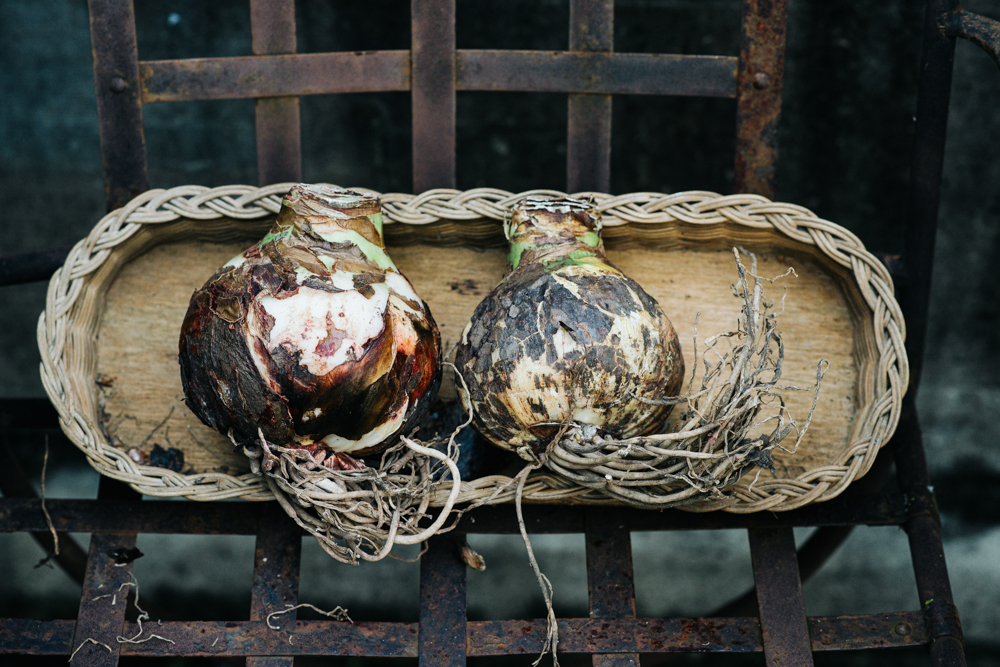
How to Store Amaryllis Bulbs (Hippeastrum)
Preserving an amaryllis bulb after flowering is not easy, but you can try.
The recipe I will leave below is written from the words of one resident of our village. Once, seeing how she put pots with hippeastrum bulbs outside, I asked her why she was doing this and received the answer: so that the bulbs would bloom the following year. Then I asked her to tell me in detail how she does it.

RECIPE
- Cut after flowering: After flowering, cut off the faded flowers with the stem (a few centimeters above the bulb). Leaves are not cut off, healthy leaves should grow and develop, since the bulb receives nutrients from them, which is very important for photosynthesis.
- Location and care in summer: From mid-May to September (depending on the climate in your region. Important: there should be no frost), place the pot outside in a bright, but not too sunny place. Water the plant regularly, but avoid stagnant water. Fertilize every two weeks with any fertilizer for flowers (even fertilizer for geraniums will do).
- Preparing for the rest phase: At the end of summer, from September to November, watering and fertilizing are gradually reduced. If the leaves turn yellow and die, cut them off completely.
- Storing onions: Remove the bulb from the soil, thoroughly clean it from excess soil and remove dead roots. Store the onion in a cool, dark and dry place at a temperature of about 10-15 °C. or you can leave the bulbs in the pot and transfer them to a cool, dark and dry place with a temperature of about 10-15 °C.
- Transplantation in autumn: In the fall, plant the bulb in fresh soil or add a little fresh soil to the pot so that a third of the bulb protrudes from the soil. Place the pot in a bright place and water moderately until new shoots appear.
I myself have not tried to save heppeastrum bulbs for a second year, but now that I have learned about this method, I will definitely try.
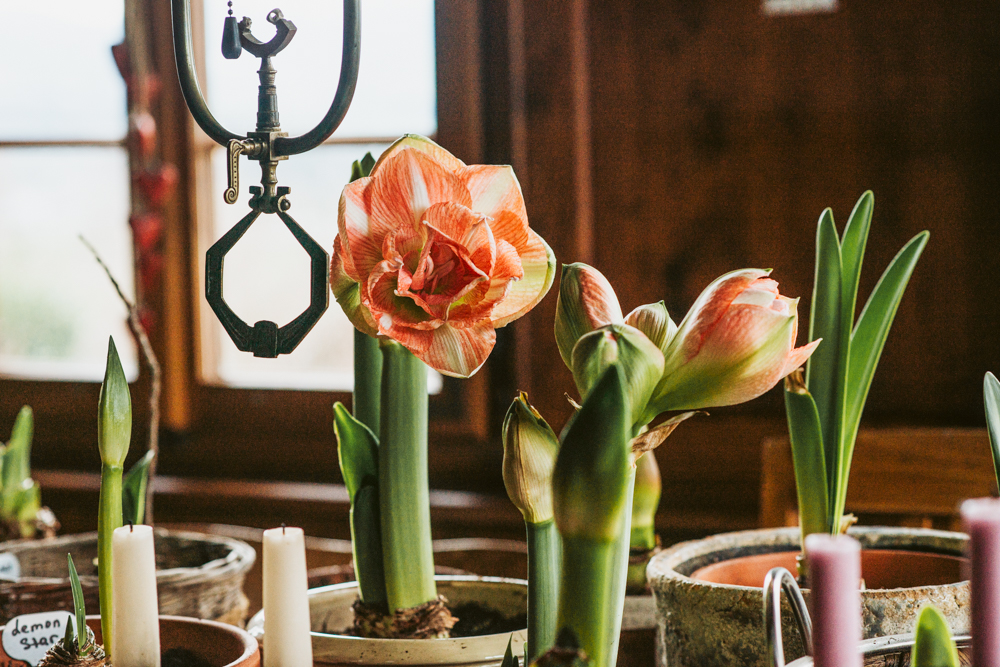
Good luck to everyone who wants to try it too!
Feel free to leave your comments and share your results, I will be very grateful!
-
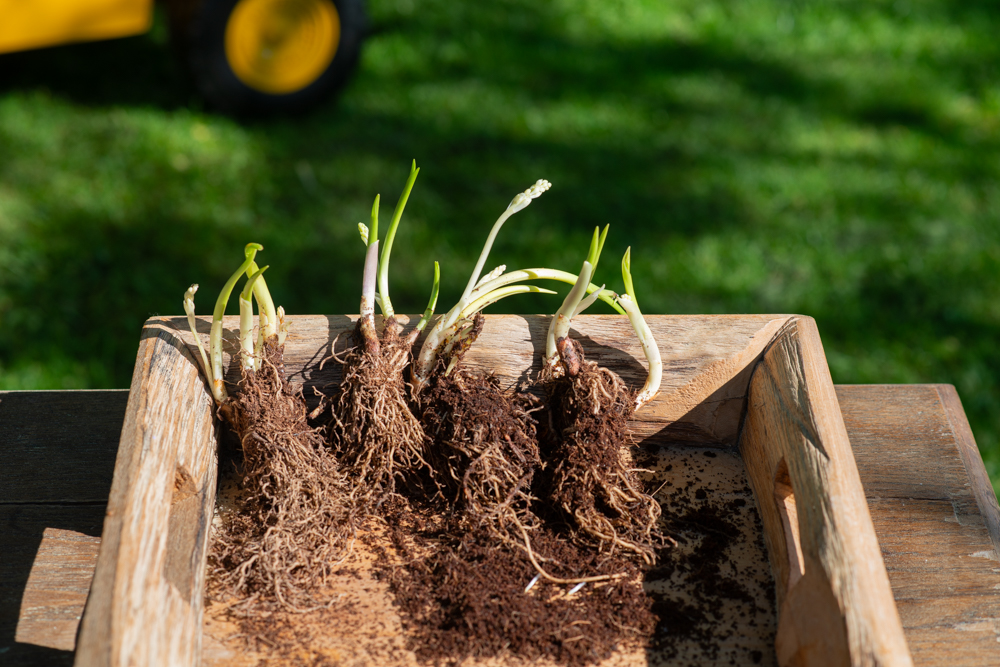
Bare-rooted plants
One of the biggest advantages of bare-root plants is the ability to easily assess their freshness and health. Bare-root plants cannot be stored for a long time, unlike plants that are already sold in containers. Therefore, if we buy bare-root plants, it means that they are fresh.
We offer a small selection of bare root plants, each plant has its own delivery time, as the freshness of our products is important to us, we do not order roots in large quantities and do not store them for a long time.
There are a number of advantages that make bare root plants a popular choice when planting and transplanting:
1. Economicalt
- Roots are usually cheaper than closed root plants (in pots or containers) because they do not require the cost of soil, containers and additional packaging materials.
2. Ease of transportation
- The absence of heavy soil makes bare-root plants easier to transport.
3. Easy inspection of roots
- Exposed roots can be easily checked for health, damage or disease before planting. This helps avoid transplanting diseased plants.
4. Better rooting
- Such plants adapt to new soil faster, since their root system immediately begins to interact with the surrounding soil.
5. Comfortable fit
- Roots can be planted at any convenient time during the season (usually fall or early spring) while the plant is dormant.
6. Eco-friendliness
- The absence of containers and minimal packaging makes this method more environmentally friendly.
Flaws
However, it is worth considering that plants with an open root system require proper handling and timely planting. The roots can dry out if they are not moistened before planting.
When planted correctly, bare root plants can be a great choice for your garden for years to come!
Here's how to determine the freshness of such plants:
1. Appearance of roots
- The roots must be moist, elastic and light (white or light brown). If they are dry, dark, or look dead, the plant is probably not fresh.
2. No damage
- The roots should not have any rotten or soft areas, cuts or signs of fungal damage.
3. State of shoots
- The shoots and branches of the plant should also be healthy: no cracks, mold or dry ends
4. Elasticity
- If you bend a root or branch slightly, it should be flexible and not break.
5. Smell
- The roots and the plant itself should smell like fresh earth. If there is an unpleasant smell of decay, this is a bad sign.
6. Packaging (upon purchase)
- If you buy exposed roots, check that they have been stored properly: the roots should be wrapped in a damp material (such as moss, sawdust, or sprinkled with peat) to prevent them from drying out.
7. Reaction to water
- If the plant seems a little dry, you can put the roots in water for a few hours. Fresh roots quickly absorb moisture and restore elasticity.
Regular inspection before planting will help avoid problems and ensure that the plants are healthy and thrive!
We wish you successful plantings!
-
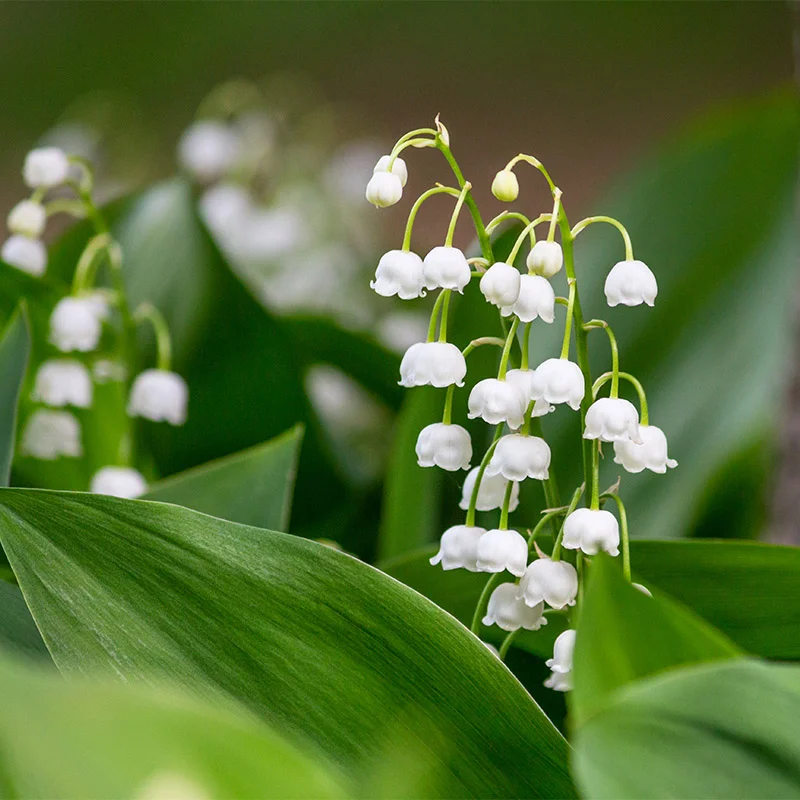
Lilies of the valley
Lily of the valley (lat. Convallaria majalis) is an elegant perennial plant known for its white bell-shaped flowers and pleasant aroma.
Origin of the name
Latin name Convallaria majalis translates as "May lily of the valleys", reflecting its natural habitat - shady forest valleys.
Who gave the name "lily of the valley"?
The Slavic name "lily of the valley" is considered to be derived from the Polish word "lęda", meaning "lowland" or "wasteland." This reflects the natural habitat of the lily of the valley - shady, low-lying wooded areas.
The Latin name of the plant is Convallaria majalis – was officially introduced by Carl Linnaeus in the 18th century.
- Convallaria comes from Latin "convallis" - "valley".
- Majalis means "May", indicating the flowering period of the plant.
Together, the name can be translated as "May lily of the valleys."
In English, lily of the valley is known as "Lily of the Valley" (Lily of the Valleys). This name, like the Latin name, emphasizes the place of growth of the plant and its similarity to lilies.
Lily of the valley also has a poetic connotation in English culture. In the Victorian language of flowers, it symbolized the return of happiness and tenderness.
Historical facts and symbols
Lilies of the valley are an amazing plant with a rich history and interesting features.
Lily of the valley is mentioned in the myths and folklore of many peoples. In ancient Greek mythology, it was associated with the goddess Diana, and in the Christian tradition it is considered a symbol of purity and modesty.
Lily of the valley symbolizes tenderness, love and rebirth, and is also widely associated with spring.
Myths and Legends
- Greece: Lily of the valley was considered a gift from the god Apollo. He supposedly grew it to shelter the nymphs from the scorching sun.
- Christianity: According to legend, lilies of the valley grew from the tears of the Virgin Mary when she mourned the crucifixion of Christ. That is why it is called "the tears of the Virgin Mary."
- Europe: The French associate the lily of the valley with the May Day holiday, which has become a symbol of good luck and love.
Cultural significance
- In England, lily of the valley is called "May lily"
- In Finland, the lily of the valley is the national flower
- In the Victorian era, lilies of the valley symbolized the "return of happiness"
Interesting facts
- Poisonous plant:
All parts of the lily of the valley contain toxic substances - cardiac glycosides. They can be dangerous for humans and animals if ingested. - Medical use:
In ancient times and in modern medicine, lily of the valley was used to treat heart disease, as well as a diuretic. - Perfumery:
The natural scent of lily of the valley is highly prized, but it is difficult to extract from the flowers. Therefore, a synthetic version is used in modern perfumery - Bloom:
Lily of the valley blooms in May-June, and each brush can contain from 5 to 15 flowers. It is one of the earliest spring plants - Ecological role:
Lilies of the valley prefer to grow in the wild – in shady forests and forest edges. They are resilient and can form dense carpets. - Varieties and varieties:
There are decorative varieties with double flowers, variegated leaves or unusual shades (for example, pink lilies of the valley).
Planting with roots
- Select a location: Lilies of the valley prefer shady or semi-shady areas. The ideal soil is moist, rich in organic matter and well-drained.
- Preparing the roots:
- Purchased or dug up rhizomes should be checked for freshness and damaged areas should be removed.
- If desired, you can soak the roots in warm water for 2-3 hours before planting.
- Landing:
- Plant the rhizomes at a depth of 2-3 cm, leaving the tops of the buds at ground level.
- The distance between plants is 10–15 cm.
- Landing time:
- Lily of the valley roots can be planted almost all year round.
Care
- Watering:
- Lilies of the valley love humidity, but do not tolerate stagnant water. Regular watering is especially important during the growing season.
- Top dressing:
- Apply organic fertilizer or compost in the spring.
- In mid-summer, you can add complex mineral fertilizer.
- Reproduction:
- Lilies of the valley grow quickly. To control this, replant the plants every 3-4 years.
- Divide the rhizomes in the fall or spring.
- Preparing for winter:
- Lilies of the valley are frost-resistant, but in regions with severe winters, cover the area with a layer of mulch or peat
- Pest Control:
- The main enemies are slugs and nematodes. Use organic products or special preparations.
- Lilies of the valley do not tolerate heat: Lily of the valley can live for decades, provided it is kept in a cool environment. It can withstand temperatures as low as -11°C. If you are growing the plant in a hotter climate or during the summer, it is important to give this plant shade. Shade is vital in the afternoon when temperatures are at their peak.
-
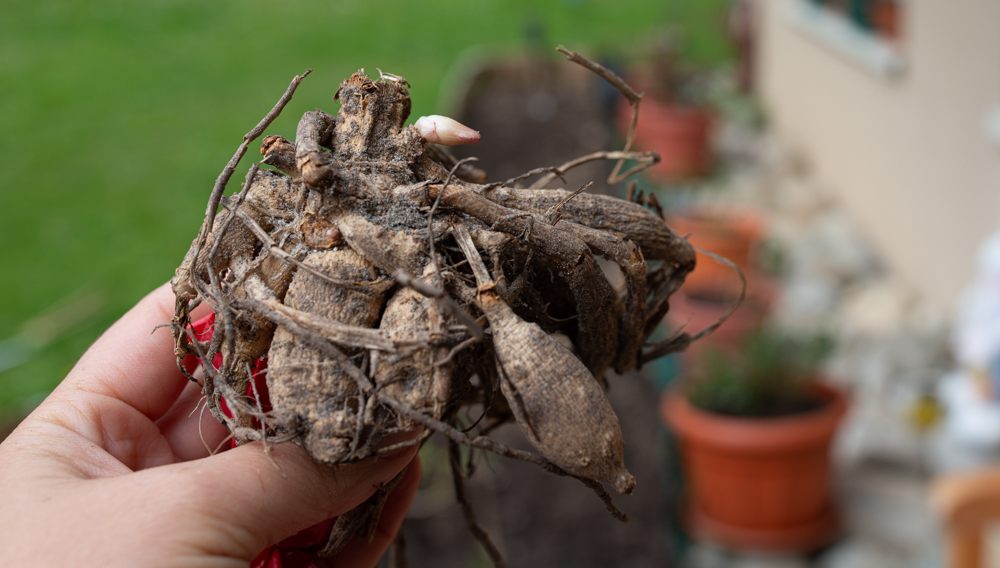
Top quality dahlia tubers for your garden
We pride ourselves on offering only the finest dahlia tubers, the most interesting varieties, to ensure your garden becomes a source of vibrant colour and elegant beauty. Our tubers are carefully selected and undergo strict quality control in our warehouse in Holland, so that you can enjoy a lush bloom.
What makes our tubers special?
- High viability: We offer only healthy and strong tubers that guarantee successful growth and flowering.
- Purity of varieties: Each tuber corresponds to its variety, which allows you to create unique compositions from dahlias of different shapes and shades
- Plant Health: All tubers are checked for disease and damage.
- Convenient packaging: Our tubers are carefully packaged to maintain their quality during transportation.
How to achieve success in growing?
We provide recommendations on the correct planting and care of dahlias so that your plants delight the eye with their lush flowering all season long.Delivery and support
We guarantee safe delivery of tubers and are always ready to help you with the choice of varieties and care advice.Let your garden bloom with us!
Order now Dahlia tubers of the highest quality today and turn your garden into a place where every flower will be a source of inspiration.Enjoy convenient delivery or use our "reserve for pickup" feature.
We wish you successful plantings and lots of beautiful flowers!
-
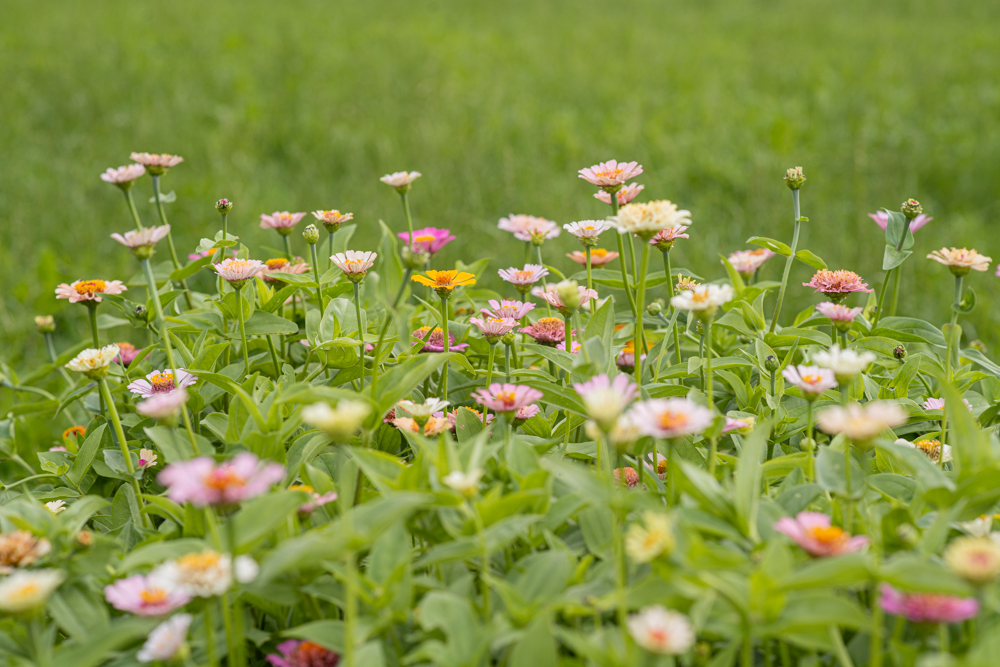
Highest quality flower seeds for your garden
We offer fresh seeds of flowers of our own collection of rare and interesting varieties that will help you create the garden of your dreams. Each seed is the result of careful selection and careful storage to guarantee high germination and excellent quality.
Why choose our seeds?
- High germination rate: We work only with fresh seeds so that you can enjoy abundant flowering
- Purity of varieties: All seeds meet the stated characteristics, including color, size and shape of plants
- Plant Health: Our seeds are fresh and high quality, which virtually eliminates the risk of disease
- Convenient packaging: Each package protects the seeds from moisture and damage, ensuring their freshness.
Planting recommendations
Along with the seeds, you receive detailed instructions on planting and care to achieve maximum results.Fast delivery and quality guarantee
Your order will be delivered within 3-4 working days. If you have any questions about choosing or caring for plants, we are always ready to help.Create your own floral paradise today!
Order now Flower seeds of the highest quality right now and make your garden a place of beauty and inspiration.Enjoy convenient delivery or use our "reserve for pickup" feature.
We wish you successful plantings and lots of beautiful flowers!
